Compressive Behavior of Circular Sawdust-Reinforced Ice-Filled Flax FRP Tubular Short Columns
Abstract
1. Introduction
2. Experimental Program
2.1. Specimens
2.2. Material Properties
2.3. Preparation of Specimens
2.4. Test Setup and Instrumentation
2.5. Melting Tests
3. Results and Discussions
3.1. General Observations
3.2. Axial Load vs. Strain Response
3.3. Axial Stress vs. Strain Behavior of Confined Ice
3.4. Lateral Dilation Behavior of Confined Ice
3.5. Hoop Strain Distribution of FRP Tube
3.6. Energy-Absorption Capacity
3.7. Melting Rate
4. Ultimate Bearing Capacity of Short Columns
5. Conclusions
- (1)
- Both PIFFT and SIFFT specimens fail by the rupture of flax FRP tubes outside the additional confinement zone. The lateral dilation and the development of cracks of the ice cores are effectively suppressed by the outer flax FRP tubes. Overall, the PIFFT and SIFFT specimens exhibit relatively brittle behavior.
- (2)
- Different from the typically bilinear curves of FRP-confined concrete, the axial stress vs. strain curves of flax FRP-confined ice are quite linear. The compressive strength of confined plain ice and sawdust-reinforced ice is approximately linearly enhanced with the increasing number of FRP layers in flax FRP tubes. Sawdust-reinforced ice cores have greater compressive strength, ultimate axial strain, and energy-absorption capacity compared with plain ice cores confined by flax FRP tubes with the same thicknesses.
- (3)
- At a given axial strain, the lateral dilation of confined sawdust-reinforced ice is smaller than that of confined plain ice. The hoop strain distribution in SIFFT specimens is more non-uniform than that observed in PIFFT specimens.
- (4)
- The melting of plain ice specimen is effectively delayed by the inclusion of sawdust and the insulation of outer flax FRP tube, while the melting rate of unconfined sawdust-reinforced ice is close to that of confined sawdust-reinforced ice due to the insulation of a layer of dry wood fiber with a low thermal conductivity after the initial melting.
- (5)
- Equations are proposed to estimate ultimate bearing capacities of PIFFT and SIFFT short columns with circular sections. The predictions are shown to be in reasonable agreement with the test results.
Author Contributions
Funding
Acknowledgments
Conflicts of Interest
References
- Schulson, E.M. Brittle failure of ice. Eng. Fract. Mech. 2001, 68, 1839–1887. [Google Scholar] [CrossRef]
- Timco, G.W.; Weeks, W.F. A review of the engineering properties of sea ice. Cold Reg. Sci. Technol. 2010, 60, 107–129. [Google Scholar] [CrossRef]
- Wu, X.; Prakash, V. Dynamic strength of distill water and lake water ice at high strain rates. Int. J. Impact Eng. 2015, 76, 155–165. [Google Scholar] [CrossRef]
- Masterson, D.M. State of the art of ice bearing capacity and ice construction. Cold Reg. Sci. Technol. 2009, 58, 99–112. [Google Scholar] [CrossRef]
- Wang, Y.; Chen, G.; Wan, B.; Lin, H.; Zhang, J. Behavior of innovative circular ice filled steel tubular stub columns under axial compression. Constr. Build. Mater. 2018, 171, 680–689. [Google Scholar] [CrossRef]
- Nixon, W.A. Alluvium-reinforced ice: A preliminary report of bending strength tests. Cold Reg. Sci. Technol. 1989, 16, 309–313. [Google Scholar] [CrossRef]
- Nixon, W.A.; Weber, L.J. Reinforcement percentage effects on bending strength of soil-ice mixtures. J. Cold Reg. Eng. 1995, 9, 152–163. [Google Scholar] [CrossRef]
- Vasiliev, N.K. On development of fibre-ice-composites. Cold Reg. Sci. Technol. 1993, 21, 195–199. [Google Scholar] [CrossRef]
- Vasiliev, N.K.; Pronk, A.D.C.; Shatalina, I.N.; Janssen, F.H.M.E.; Houben, R.W.G. A review on the development of reinforced ice for use as a building material in cold regions. Cold Reg. Sci. Technol. 2015, 115, 56–63. [Google Scholar] [CrossRef]
- Bai, Y.; Yan, Z.; Ozbakkaloglu, T.; Han, Q.; Dai, J.; Zhu, D. Quasi-static and dynamic tensile properties of large-rupture-strain (LRS) polyethylene terephthalate fiber bundle. Constr. Build. Mater. 2020, 232, 117241. [Google Scholar] [CrossRef]
- He, J.; Xian, G.; Zhang, Y.X. Effect of moderately elevated temperatures on bond behaviour of CFRP-to-steel bonded joints using different adhesives. Constr. Build. Mater. 2020, 241, 118057. [Google Scholar] [CrossRef]
- Huang, H.; Jia, B.; Lian, J.; Wang, W. Experimental investigation on the tensile performance of resin-filled steel pipe splices of BFRP bars. Constr. Build. Mater. 2020, 242, 118018. [Google Scholar] [CrossRef]
- Zhang, B.; Feng, G.; Wang, Y.; Lai, C.; Wang, C.; Hu, X. Elliptical FRP-concrete-steel double-skin tubular columns under monotonic axial compression. Adv. Polym. Technol. 2020, 2020, 7573848. [Google Scholar] [CrossRef]
- Lu, M.; Xiao, H.; Liu, M.; Li, X. Improved interfacial strength of SiO2 coated carbon fiber in cement matrix. Cem. Concr. Compos. 2018, 91, 21–28. [Google Scholar] [CrossRef]
- Wang, Y.; Wang, Y.; Han, B.; Wan, B.; Cai, G.; Chang, R. In situ strain and damage monitoring of GFRP laminates incorporating carbon nanofibers under tension. Polymers 2018, 10, 777. [Google Scholar] [CrossRef]
- Wang, Y.; Wang, Y.; Wan, B.; Han, B.; Cai, G.; Chang, R. Strain and damage self-sensing of basalt fiber reinforced polymer laminates fabricated with carbon nanofibers/epoxy composites under tension. Compos. Part A Appl. Sci. Manuf. 2018, 113, 40–52. [Google Scholar] [CrossRef]
- Li, J.; Xie, J.; Liu, F.; Lu, Z. A critical review and assessment for FRP-concrete bond systems with epoxy resin exposed to chloride environments. Compos. Struct. 2019, 229, 111372. [Google Scholar] [CrossRef]
- Zhai, K.; Fang, H.; Fu, B.; Wang, F.; Hu, B. Mechanical response of externally bonded CFRP on repair of PCCPs with broken wires under internal water pressure. Constr. Build. Mater. 2020, 239, 117878. [Google Scholar] [CrossRef]
- Wei, Y.; Zhang, X.; Wu, G.; Zhou, Y. Behaviour of concrete confined by both steel spirals and fiber-reinforced polymer under axial load. Compos. Struct. 2018, 192, 577–591. [Google Scholar] [CrossRef]
- Wang, Y.; Zhang, X.; Cai, G.; Wan, B.; Waldmann, D.; Qu, Y. A new thickness-based accelerated aging test methodology for resin materials: Theory and preliminary experimental study. Constr. Build. Mater. 2018, 186, 986–995. [Google Scholar] [CrossRef]
- Zhang, Y.; Wei, Y.; Bai, J.; Zhang, Y. Stress-strain model of an FRP-confined concrete filled steel tube under axial compression. Thin Walled Struct. 2019, 142, 149–159. [Google Scholar] [CrossRef]
- Zhang, X.; Wang, Y.; Wan, B.; Cai, G.; Qu, Y. Effect of specimen thicknesses on water absorption and flexural strength of CFRP laminates subjected to water or alkaline solution immersion. Constr. Build. Mater. 2019, 208, 314–325. [Google Scholar] [CrossRef]
- Mirmiran, A.; Shahawy, M. A new concrete-filled hollow FRP composite column. Compos. Part B 1996, 27, 263–268. [Google Scholar] [CrossRef]
- Zeng, J.; Gao, W.; Duan, Z.; Bai, Y.; Guo, Y.; Ouyang, L. Axial compressive behavior of polyethylene terephthalate/carbon FRP-confined seawater sea-sand concrete in circular columns. Constr. Build. Mater. 2020, 234, 117383. [Google Scholar] [CrossRef]
- Bai, Y.; Dai, J.; Mohammadi, M.; Lin, G.; Mei, S. Stiffness-based design-oriented compressive stress-strain model for large-rupture-strain (LRS) FRP-confined concrete. Compos. Struct. 2019, 223, 110953. [Google Scholar] [CrossRef]
- Pi, Z.; Xiao, H.; Du, J.; Liu, M.; Li, H. Interfacial microstructure and bond strength of nano-SiO2-coated steel fibers in cement matrix. Cem. Concr. Compos. 2019, 103, 1–10. [Google Scholar] [CrossRef]
- Cao, Q.; Tao, J.; Ma, Z.J.; Wu, Z. Axial compressive behavior of CFRP-confined expansive concrete columns. ACI Struct. J. 2017, 114, 475–485. [Google Scholar] [CrossRef][Green Version]
- Cao, Q.; Tao, J.; Wu, Z.; Ma, Z.J. Behavior of FRP-steel confined concrete tubular columns made of expansive self-consolidating concrete under axial compression. J. Compos. Constr. 2017, 21, 04017037. [Google Scholar] [CrossRef]
- Wang, Y.; Cai, G.; Li, Y.; Waldmann, D.; Larbi, A.S.; Tsavdaridis, K.D. Behavior of circular fiber-reinforced polymer-steel-confined concrete columns subjected to reversed cyclic loads: Experimental studies and finite-element analysis. J. Struct. Eng. 2019, 145, 04019085. [Google Scholar] [CrossRef]
- Dong, Z.; Wu, G.; Zhao, X.; Zhu, H.; Wei, Y.; Yan, Z. Mechanical properties of discrete BFRP needles reinforced seawater sea-sand concrete-filled GFRP tubular stub columns. Constr. Build. Mater. 2020, 244, 118330. [Google Scholar] [CrossRef]
- Alkbir, M.F.M.; Sapuan, S.M.; Nuraini, A.A.; Ishak, M.R. Fibre properties and crashworthiness parameters of natural fibre-reinforced composite structure: A literature review. Compos. Struct. 2016, 148, 59–73. [Google Scholar] [CrossRef]
- Bachtiar, E.V.; Kurkowiak, K.; Yan, L.; Kasal, B. Thermal stability, fire performance, and mechanical properties of natural fibre fabric-reinforced polymer composites with different fire retardants. Polymers 2019, 11, 699. [Google Scholar] [CrossRef] [PubMed]
- Wang, Y.; Wang, Y.; Wan, B.; Han, B.; Cai, G.; Li, Z. Properties and mechanisms of self-sensing carbon nanofibers/epoxy composites for structural health monitoring. Compos. Struct. 2018, 200, 669–678. [Google Scholar] [CrossRef]
- Dittenber, D.B.; Gangarao, H.V.S. Critical review of recent publications on use of natural composites in infrastructure. Compos. Part A Appl. Sci. Manuf. 2012, 43, 1419–1429. [Google Scholar] [CrossRef]
- Yan, L.; Chouw, N. Experimental study of flax FRP tube encased coir fibre reinforced concrete composite column. Constr. Build. Mater. 2013, 40, 1118–1127. [Google Scholar] [CrossRef]
- Yan, L.; Chouw, N. Compressive and flexural behaviour and theoretical analysis of flax fibre reinforced polymer tube encased coir fibre reinforced concrete composite. Mater. Des. 2013, 52, 801–811. [Google Scholar] [CrossRef]
- Xia, Y.; Xian, G.; Wang, Z.; Li, H. Static and cyclic compressive properties of self-compacting concrete-filled flax fiber-reinforced polymer tubes. J. Compos. Constr. 2016, 20, 04016046. [Google Scholar] [CrossRef]
- Kymäläinen, H.R.; Sjöberg, A.M. Flax and hemp fibres as raw materials for thermal insulations. Build. Environ. 2008, 43, 1261–1269. [Google Scholar] [CrossRef]
- Wang, Y.; Chen, G.; Wan, B.; Cai, G.; Zhang, Y. Behavior of circular ice-filled self-luminous FRP tubular stub columns under axial compression. Constr. Build. Mater. 2020, 232, 117287. [Google Scholar] [CrossRef]
- ASTM International. Standard Test Method for Tensile Properties of Polymer Matrix Composite Materials (ASTM D3039/D3039M-17); ASTM International: West Conshohocken, PA, USA, 2017. [Google Scholar]
- Lam, L.; Teng, J.G. Ultimate condition of fiber reinforced polymer-confined concrete. J. Compos. Constr. 2004, 8, 539–548. [Google Scholar] [CrossRef]
- Standards Press of China. Fiber-Reinforced Thermosetting Plastic Composites Pipe-Determination for Longitudinal Compressive Properties (GB/T 5350-2005); Standards Press of China: Beijing, China, 2005. [Google Scholar]
- Wang, Y.; Chen, G.; Wan, B.; Lin, H. Axial compressive behavior of square ice filled steel tubular stub columns. Constr. Build. Mater. 2018, 188, 198–209. [Google Scholar] [CrossRef]
- Xia, Y.; Xian, G.; Kafodya, I.; Li, H. Compression behavior of concrete cylinders externally confined by flax fiber reinforced polymer sheets. Adv. Struct. Eng. 2014, 17, 1825–1833. [Google Scholar] [CrossRef]
- Al-saadi, A.U.; Aravinthan, T.; Lokuge, W. Structural applications of fibre reinforced polymer (FRP) composite tubes: A review of columns members. Compos. Struct. 2018, 204, 513–524. [Google Scholar] [CrossRef]
- D’Amato, M.; Braga, F.; Gigliotti, R.; Kunnath, S.; Laterza, M. A numerical general-purpose confinement model for non-linear analysis of R/C members. Comput. Struct. 2012, 102, 64–75. [Google Scholar] [CrossRef]
- Laterza, M.; D’Amato, M.; Braga, F.; Gigliotti, R. Extension to rectangular section of an analytical model for concrete confined by steel stirrups and/or FRP jackets. Compos. Struct. 2017, 176, 910–922. [Google Scholar] [CrossRef]
- Mander, J.B.; Priestley, M.J.N.; Park, R. Theoretical stress-strain model for confined concrete. J. Struct. Eng. 1988, 114, 1804–1826. [Google Scholar] [CrossRef]
- Pessiki, S.; Harries, K.A.; Kestner, J.T.; Sause, R.; Ricles, J.M. Axial behavior of reinforced concrete columns confined with FRP jackets. J. Compos. Constr. 2001, 5, 237–245. [Google Scholar] [CrossRef]
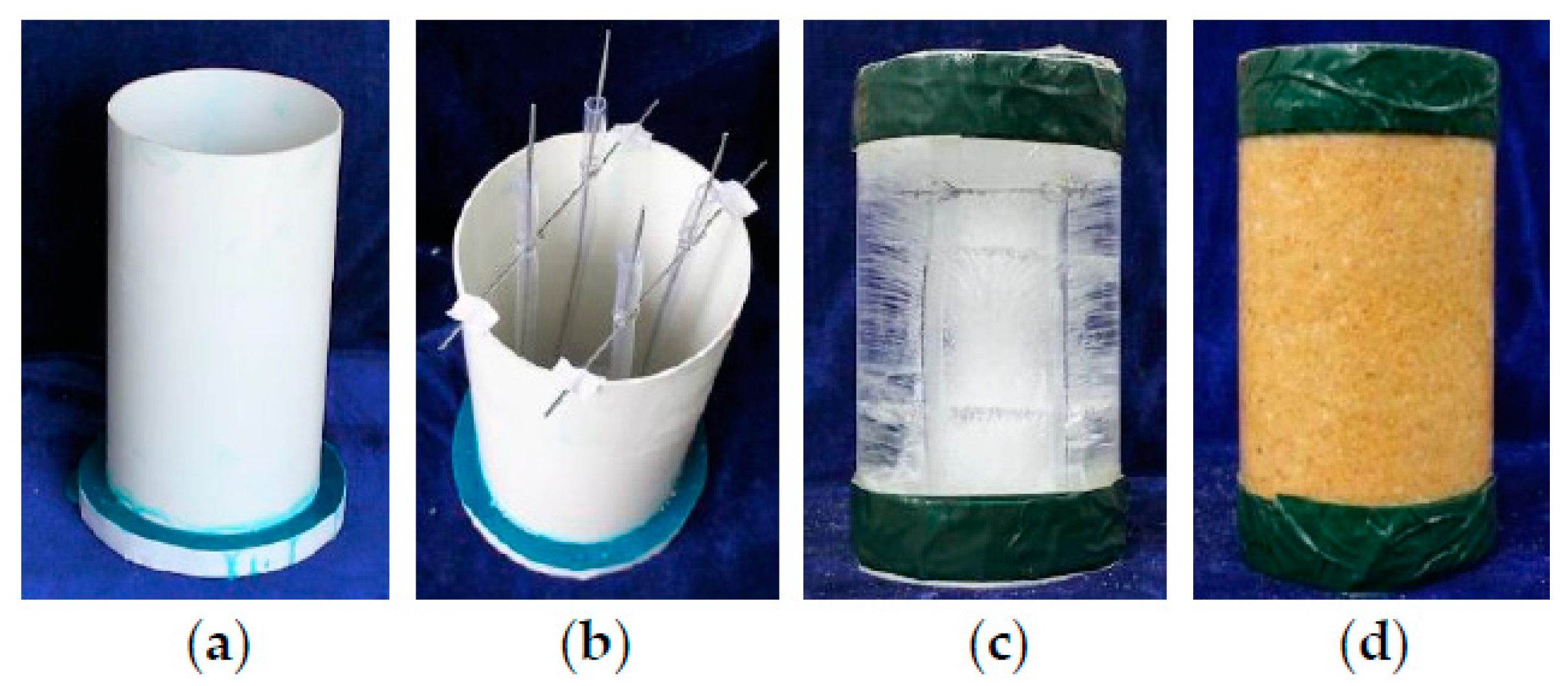
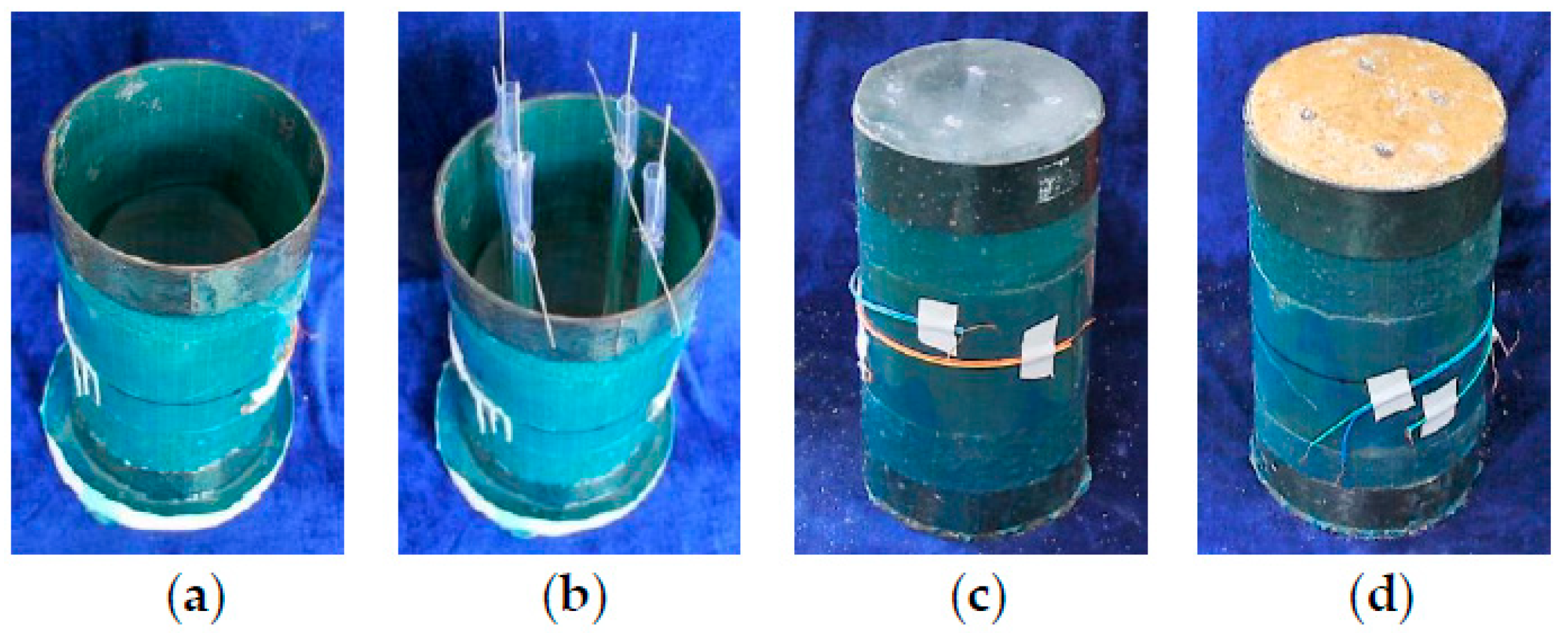
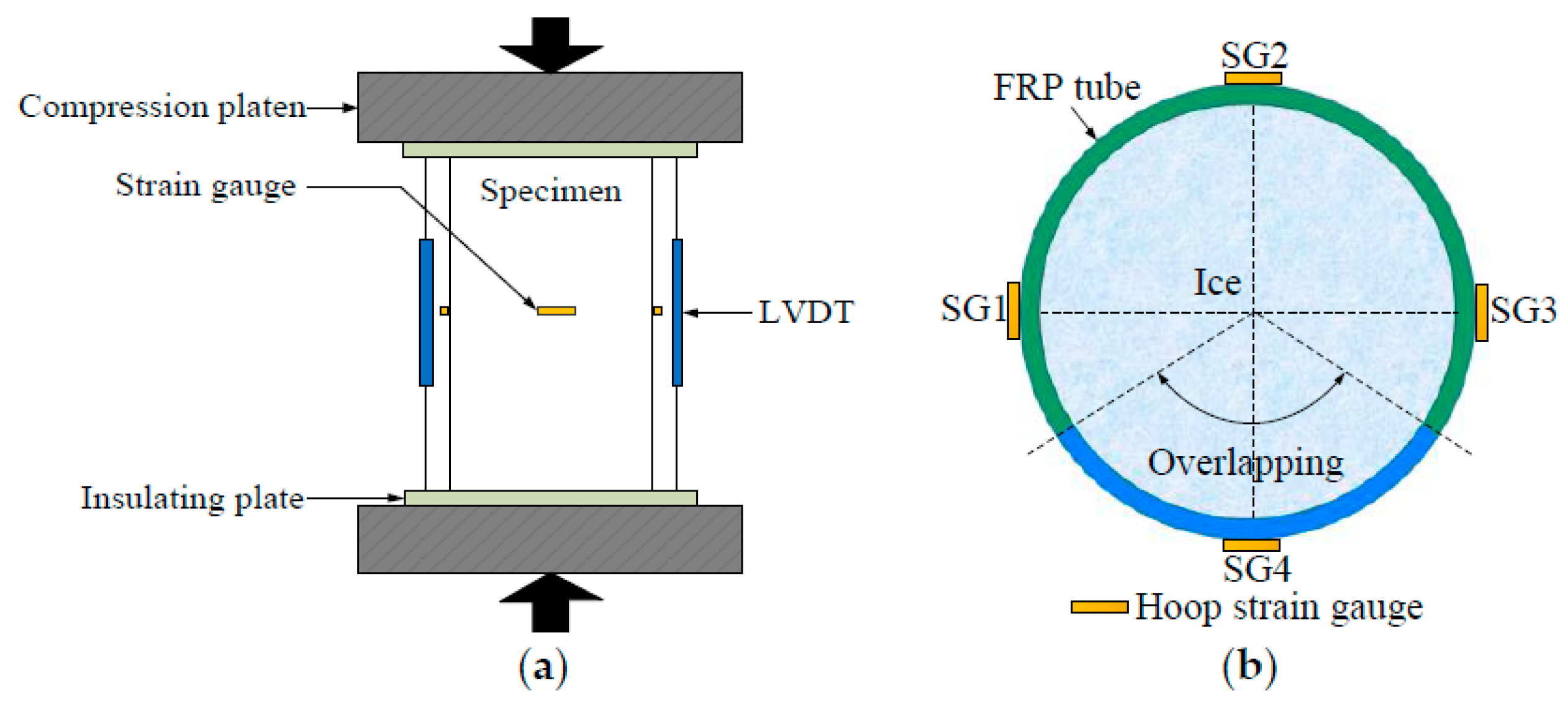

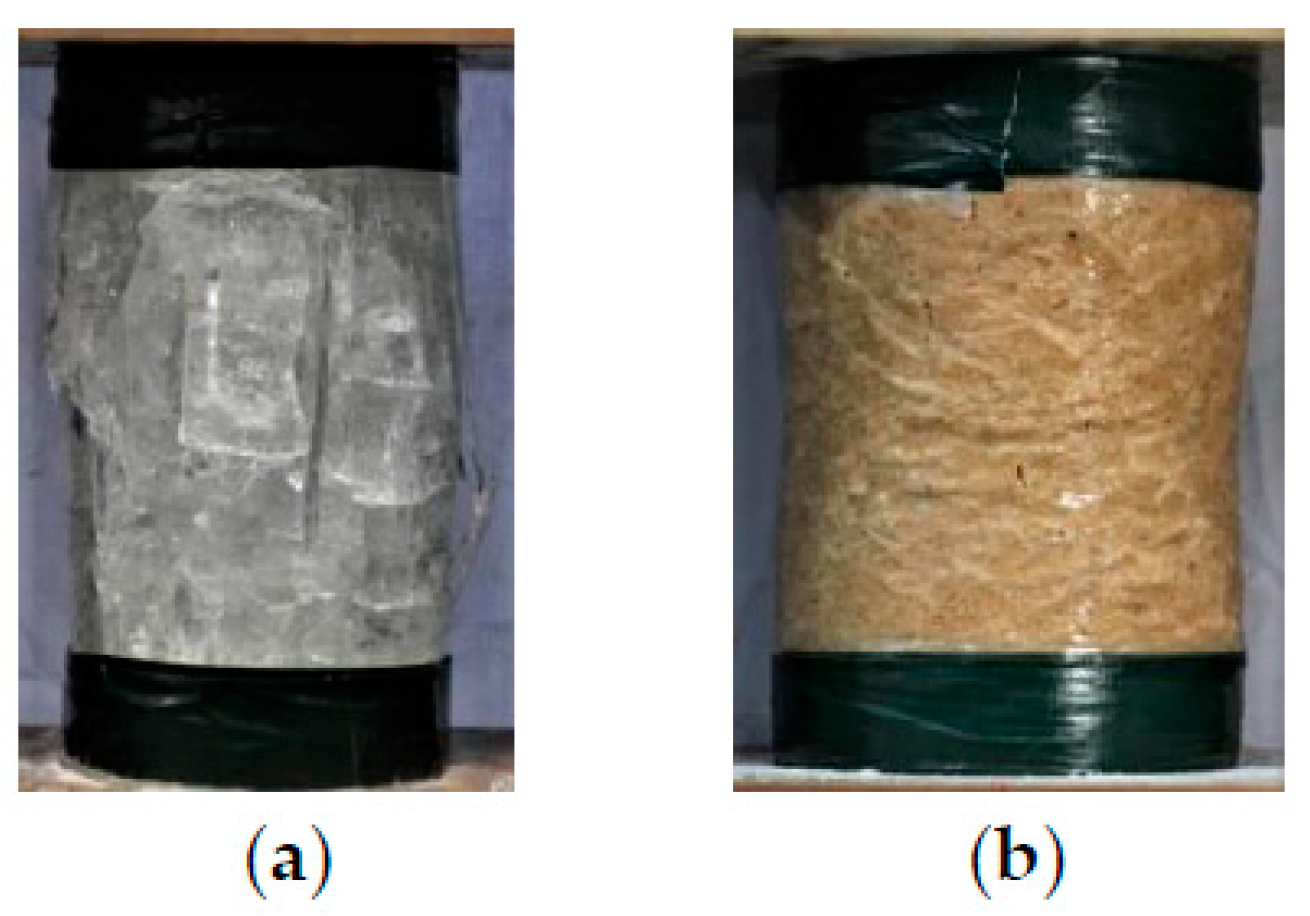
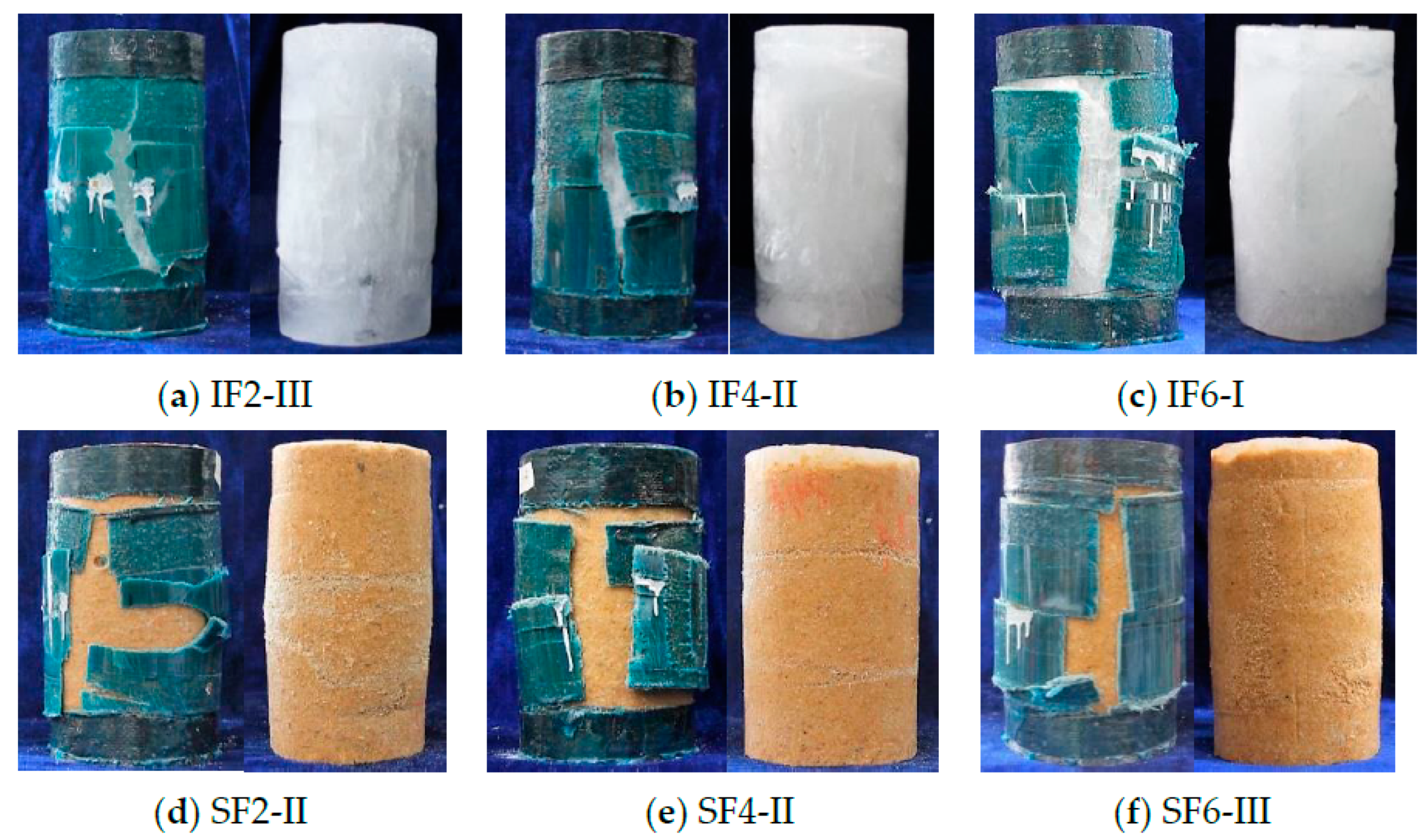
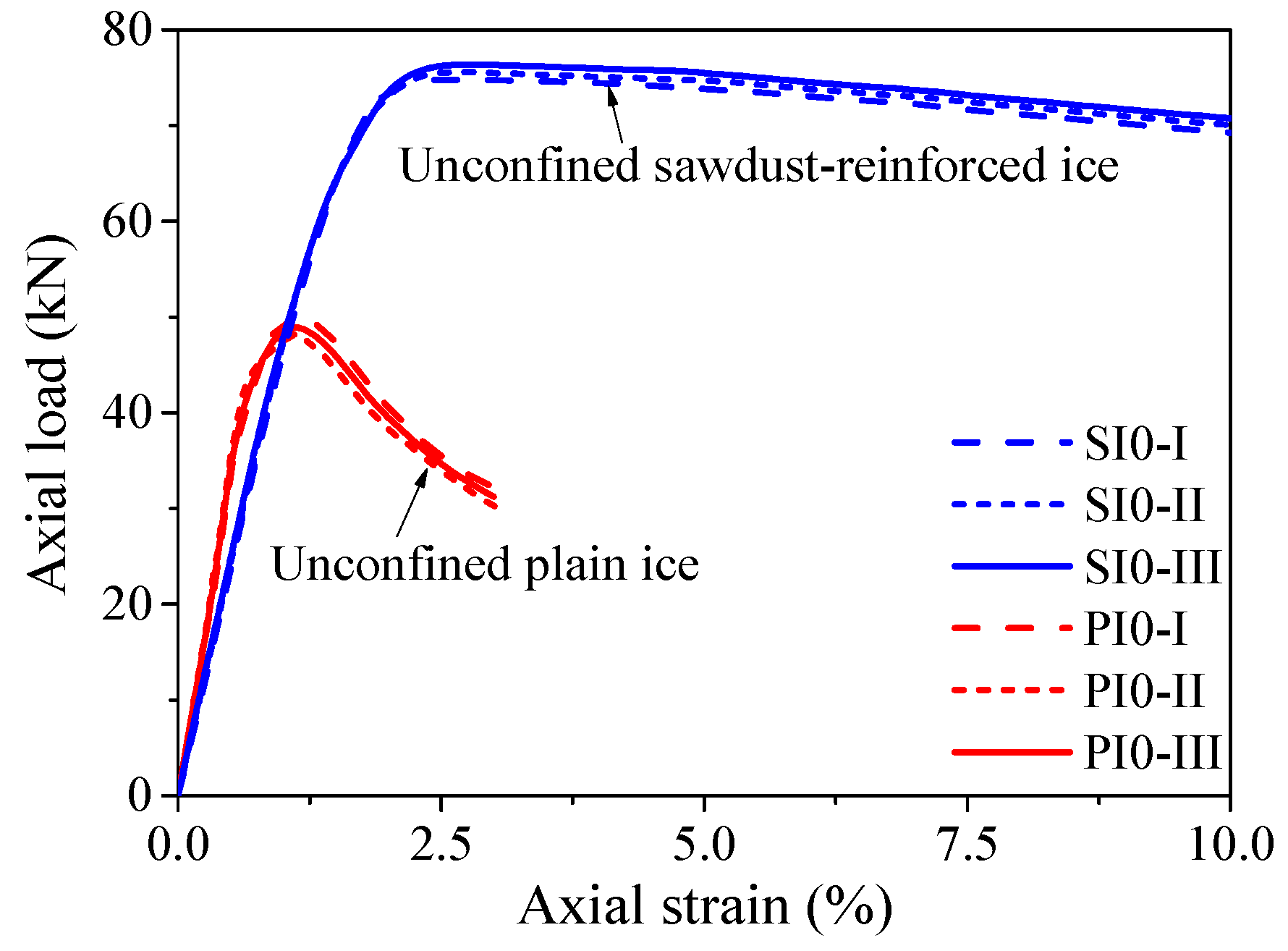
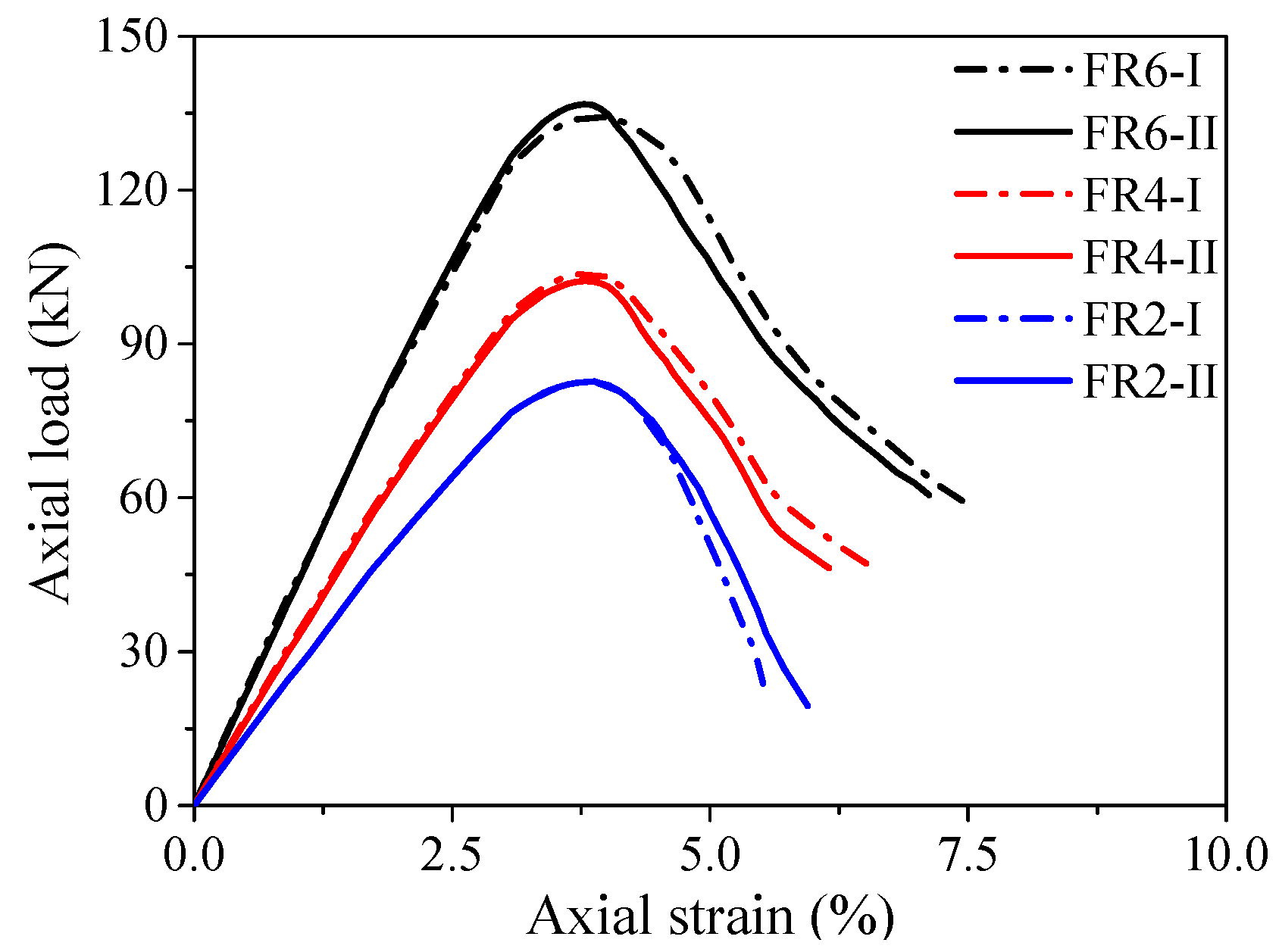
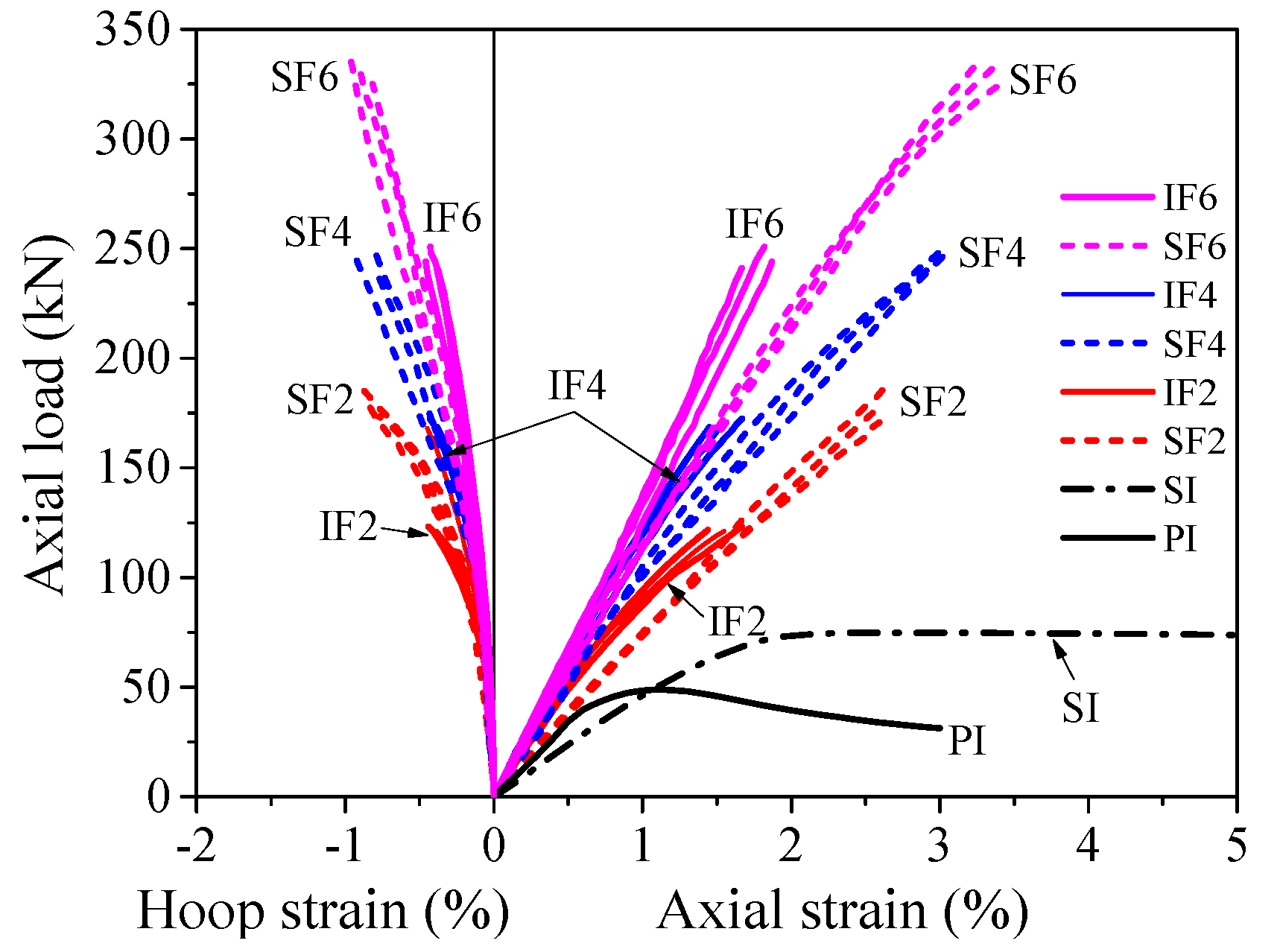
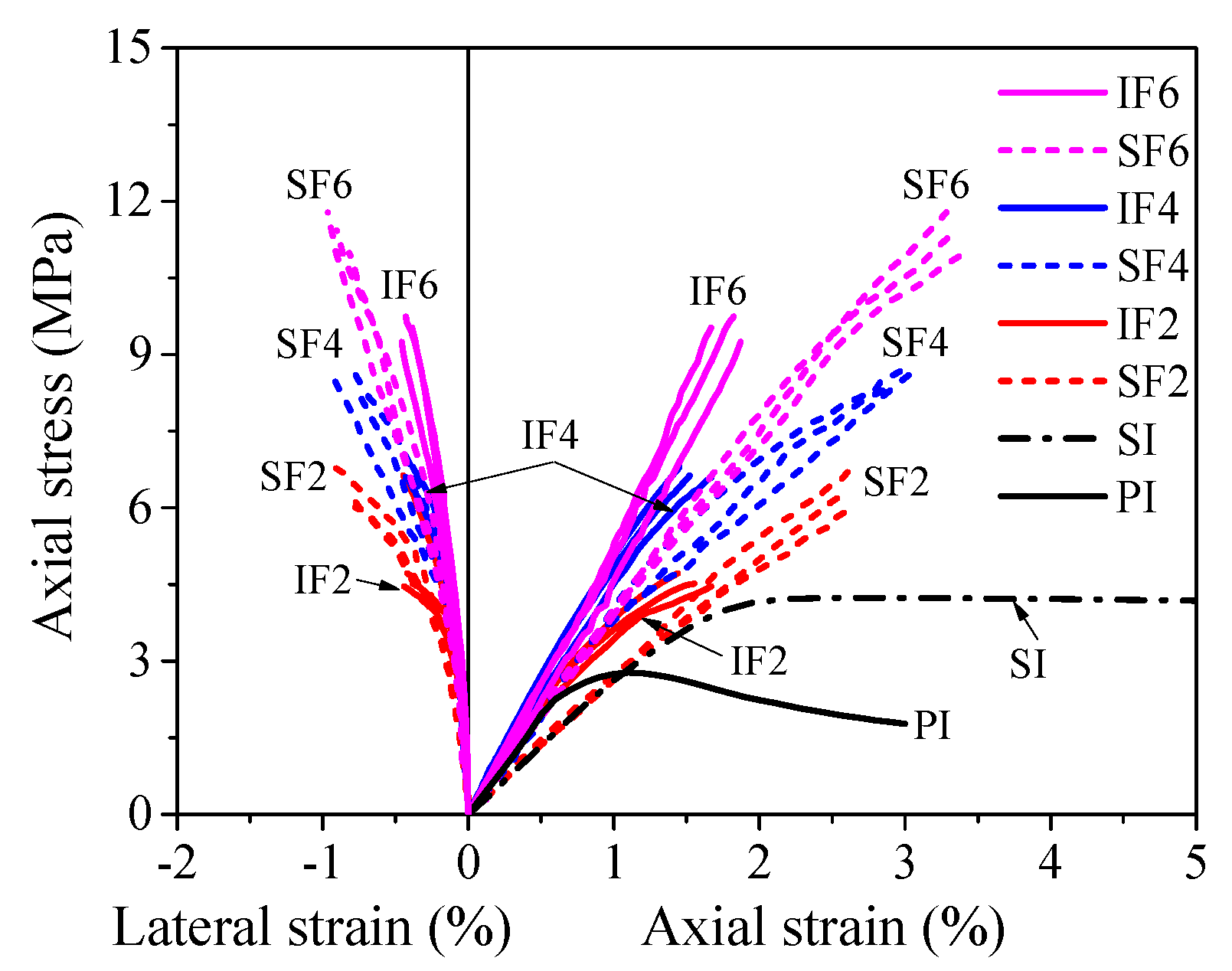
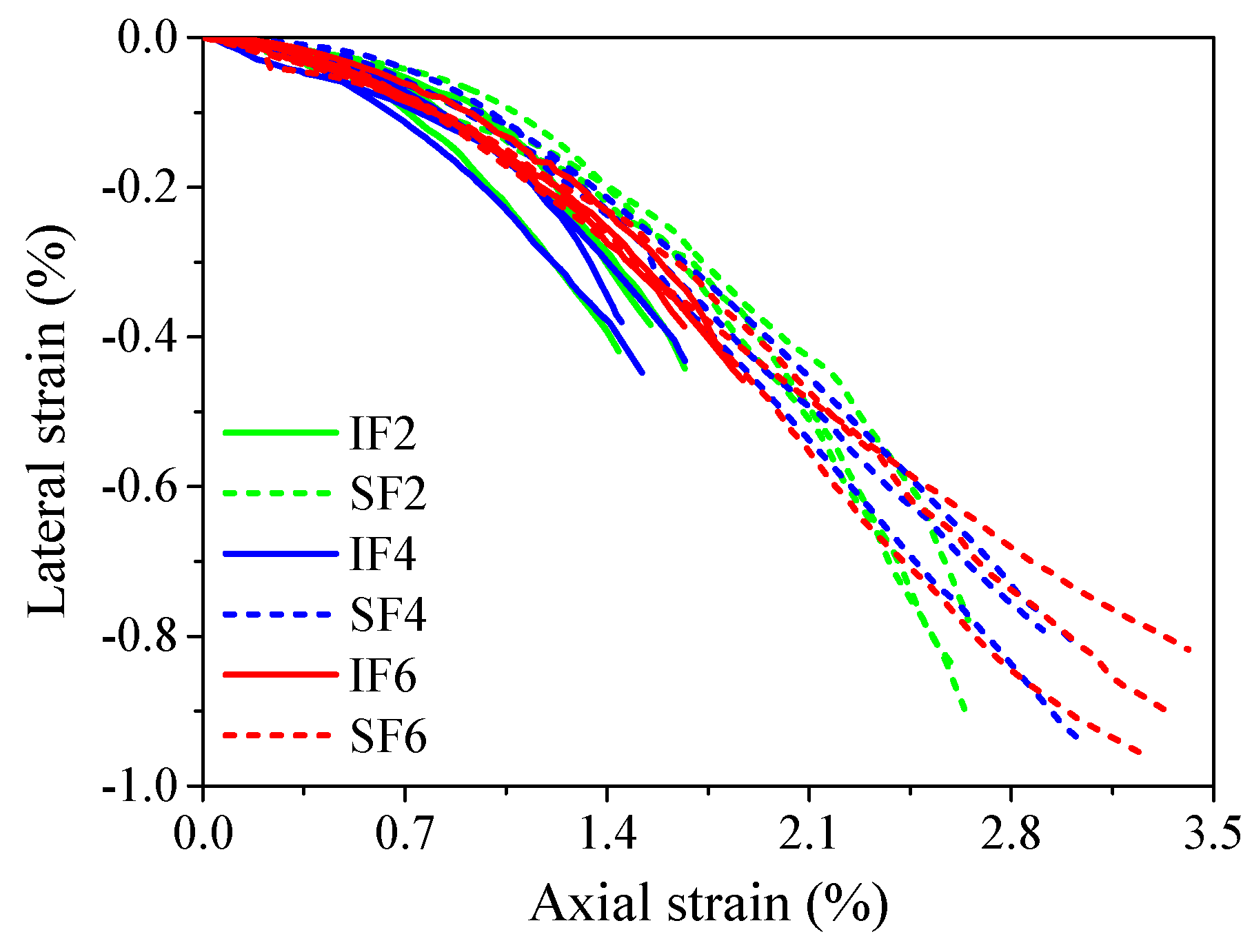
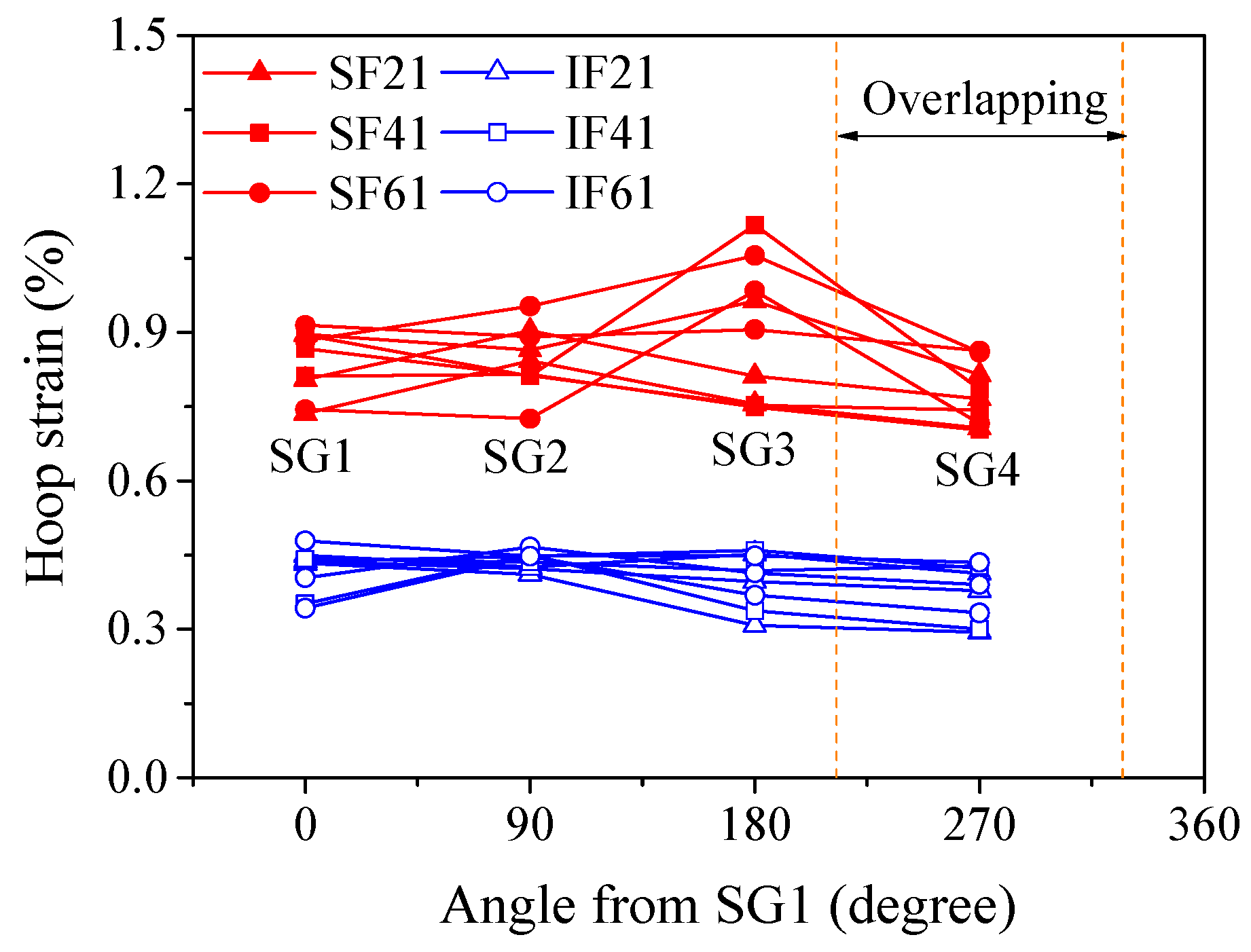
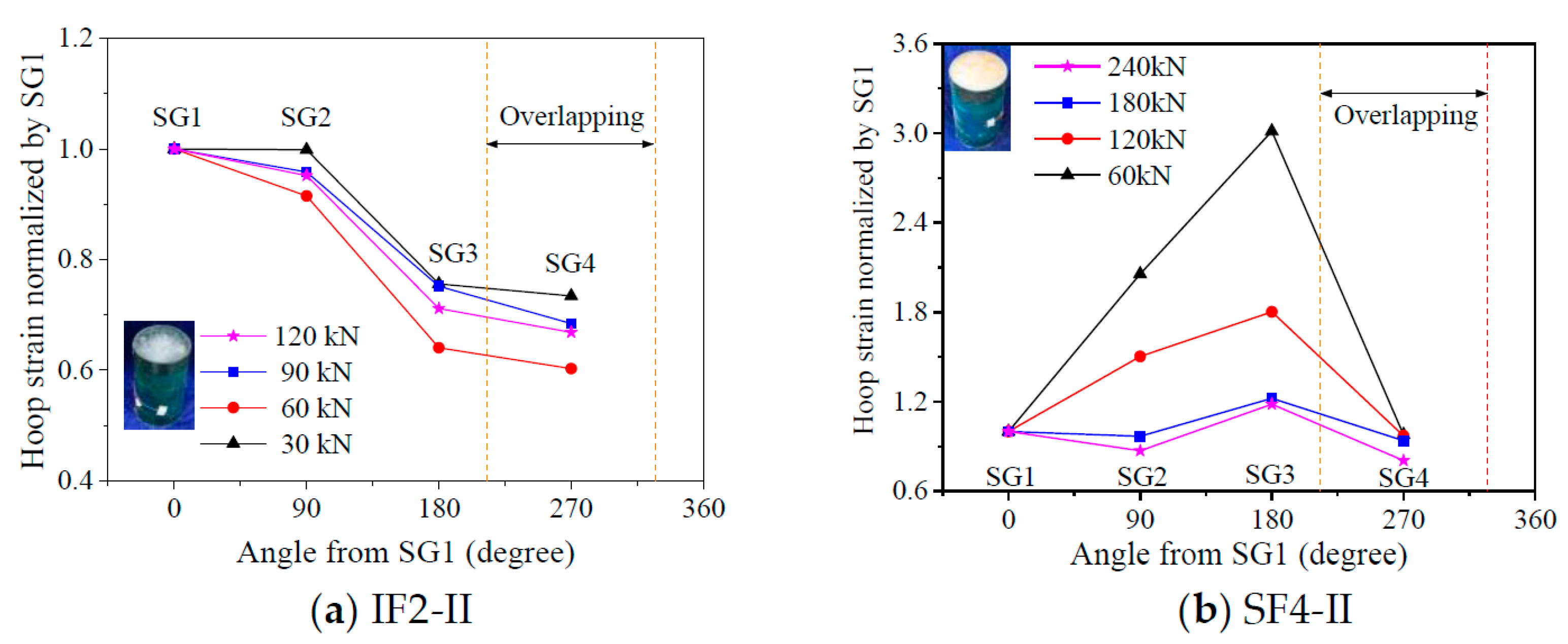
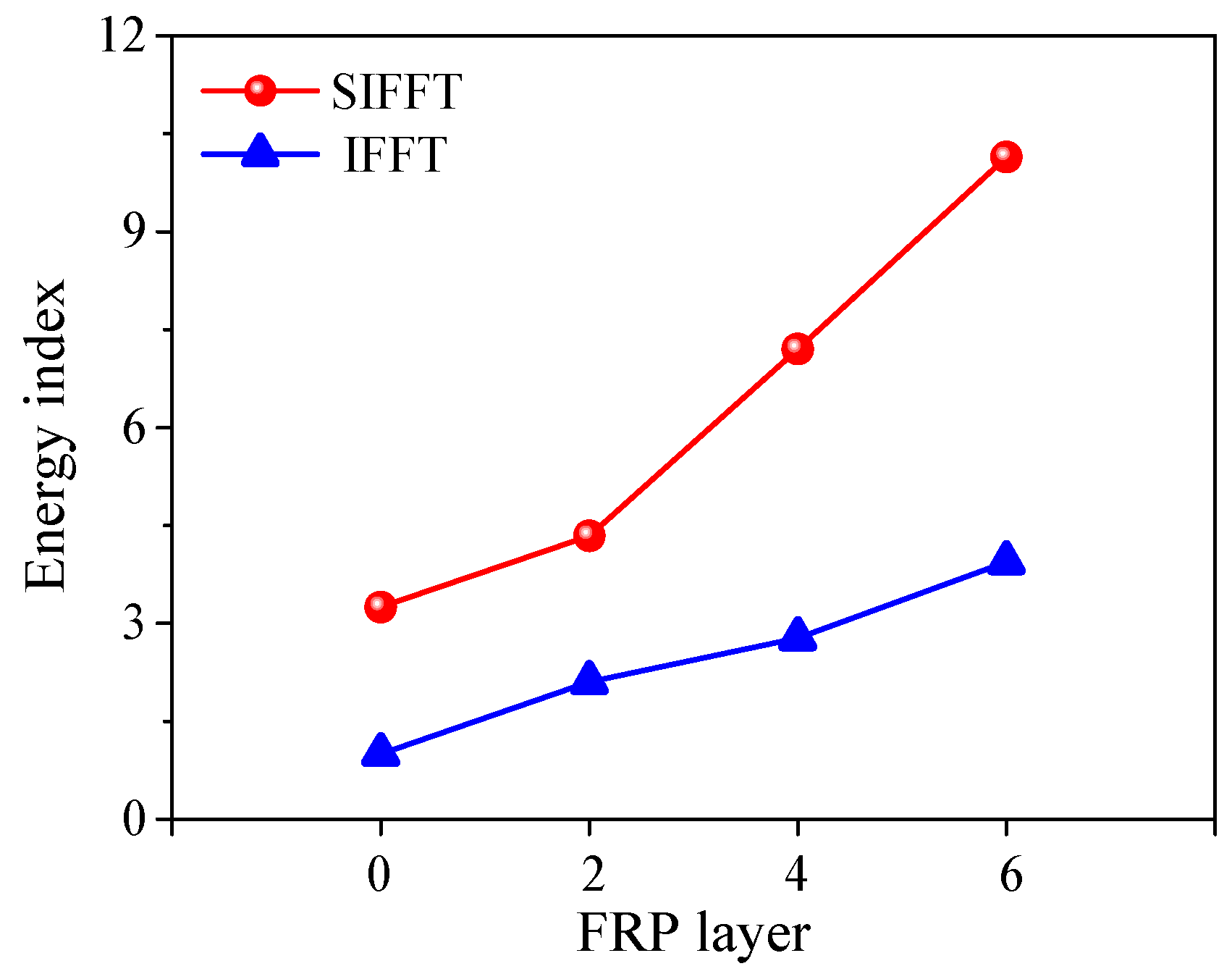
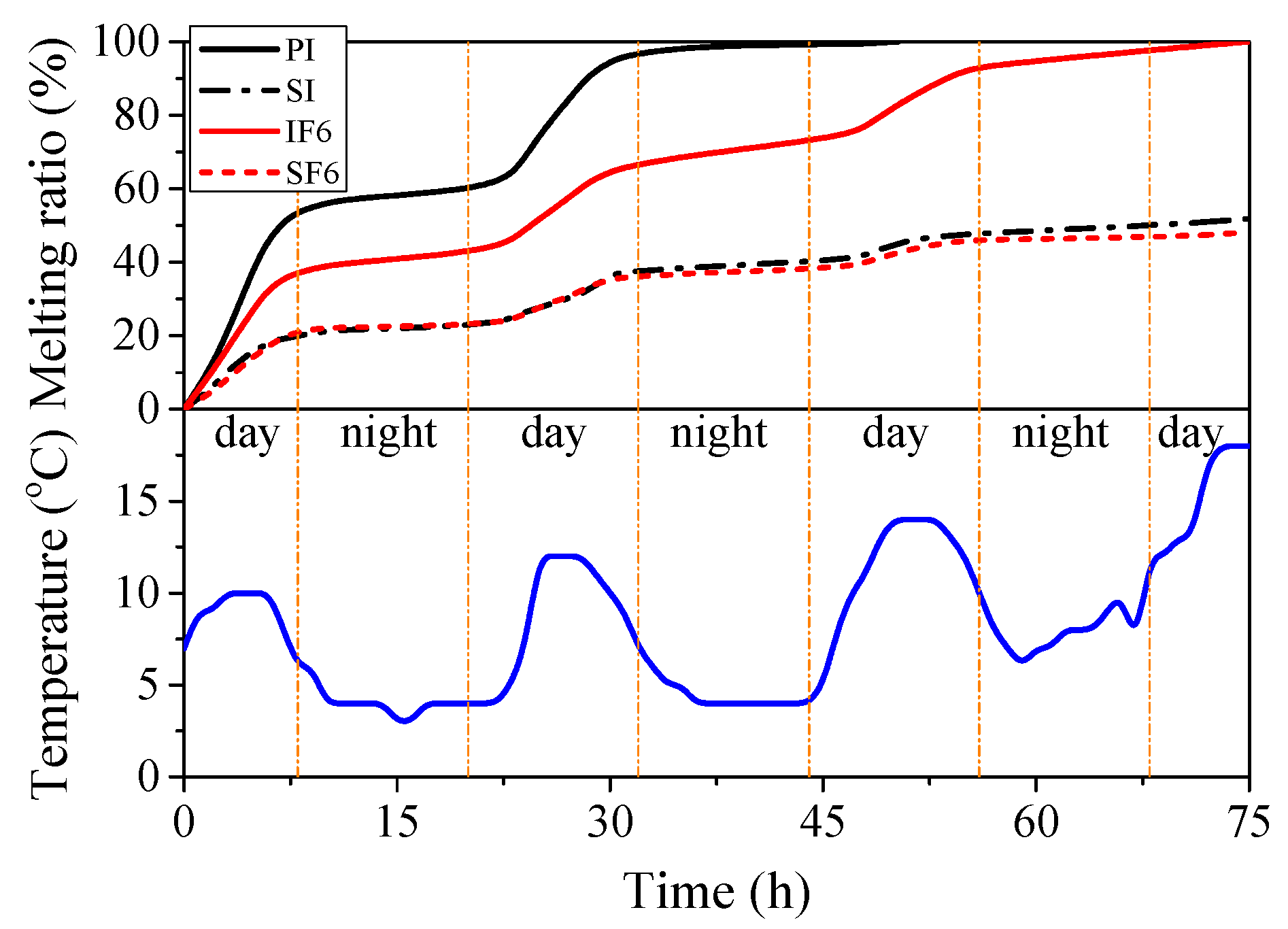
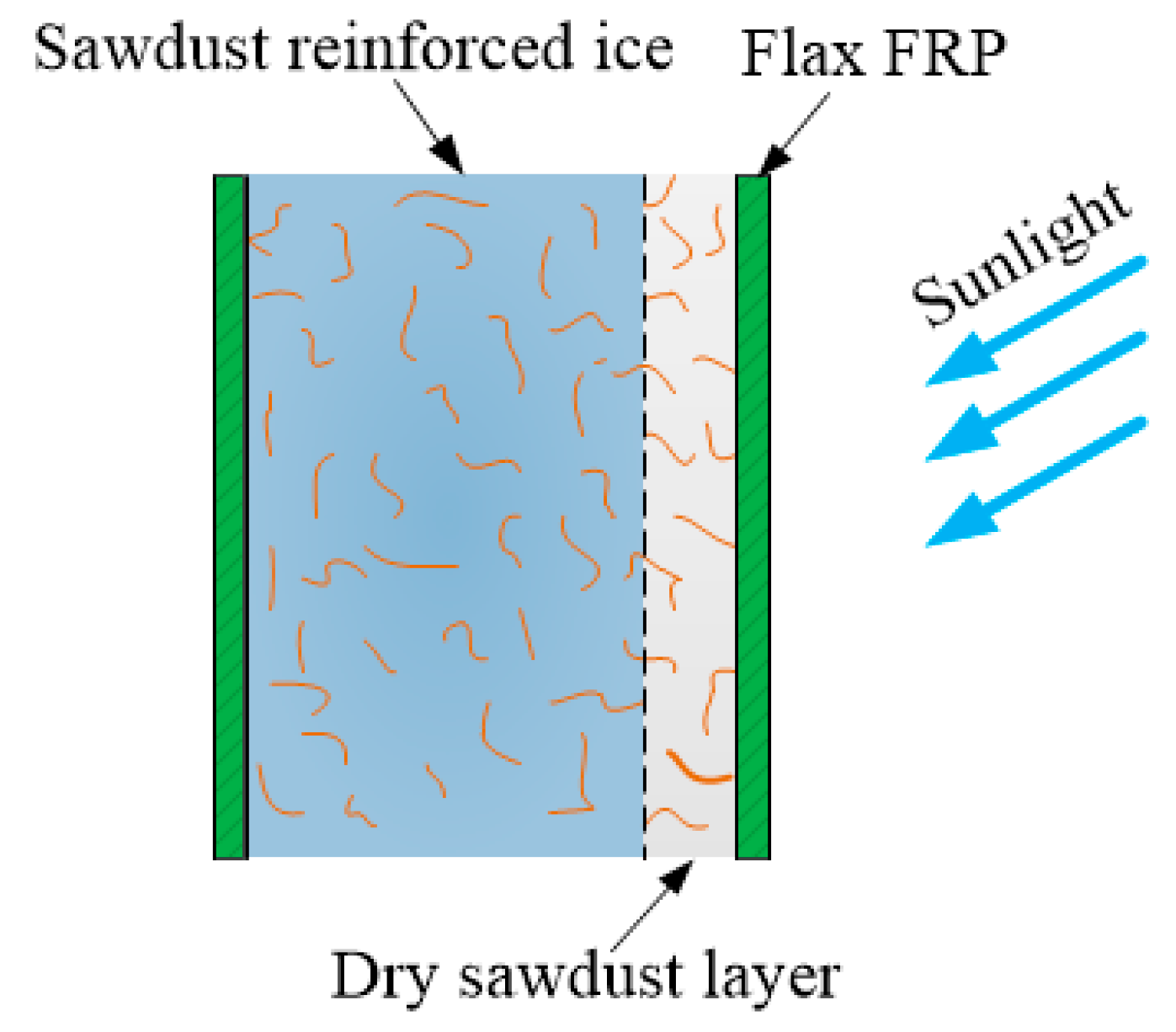
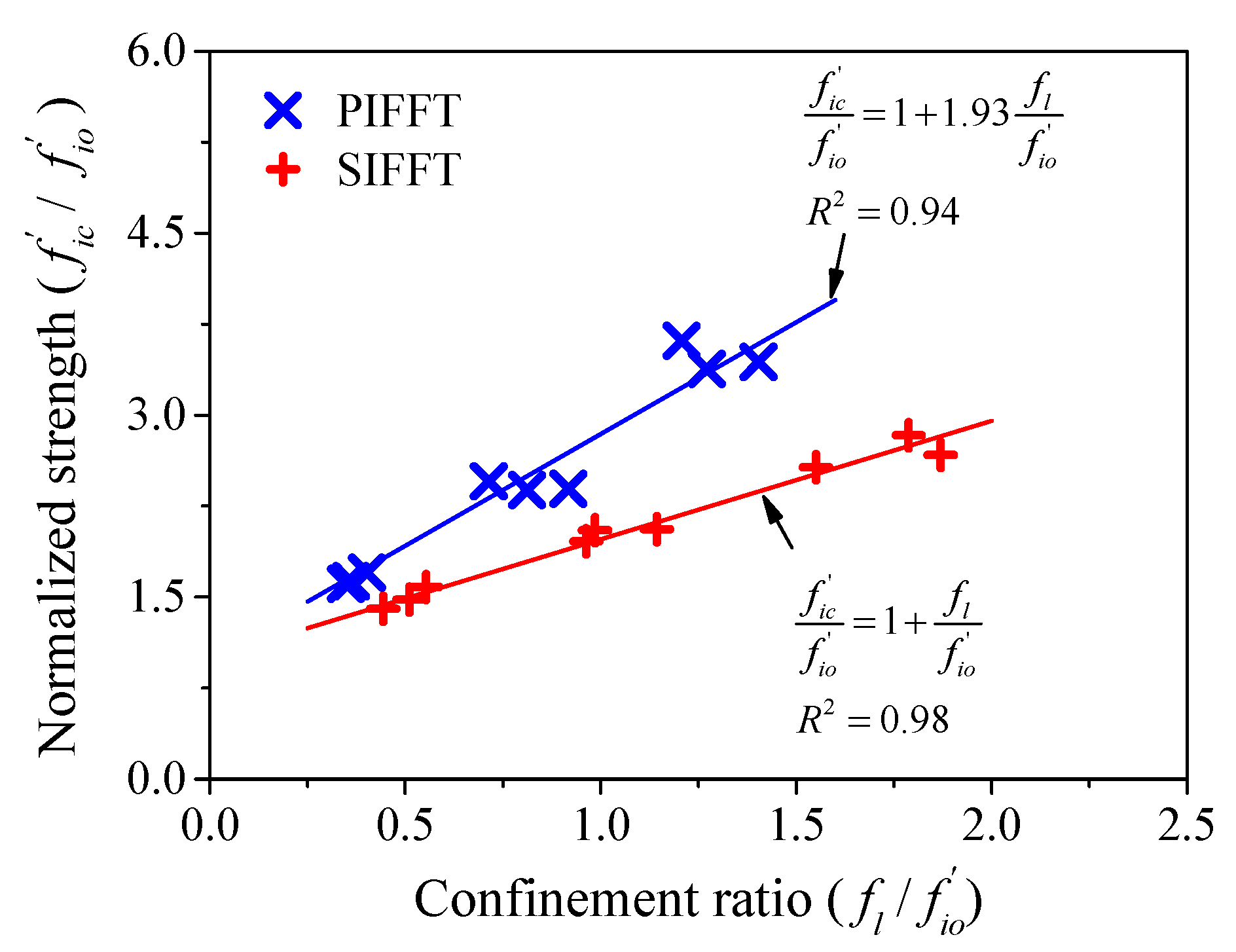
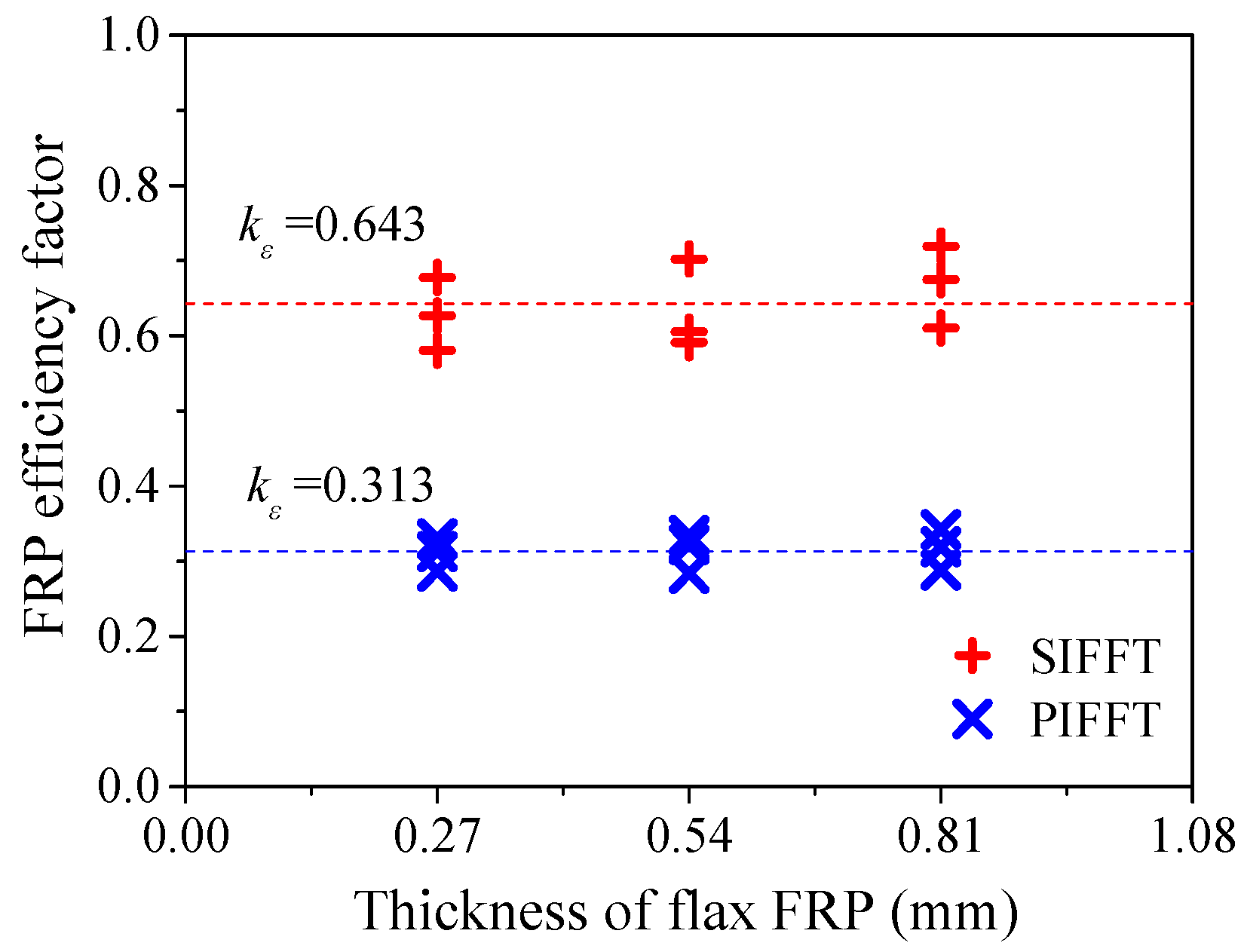
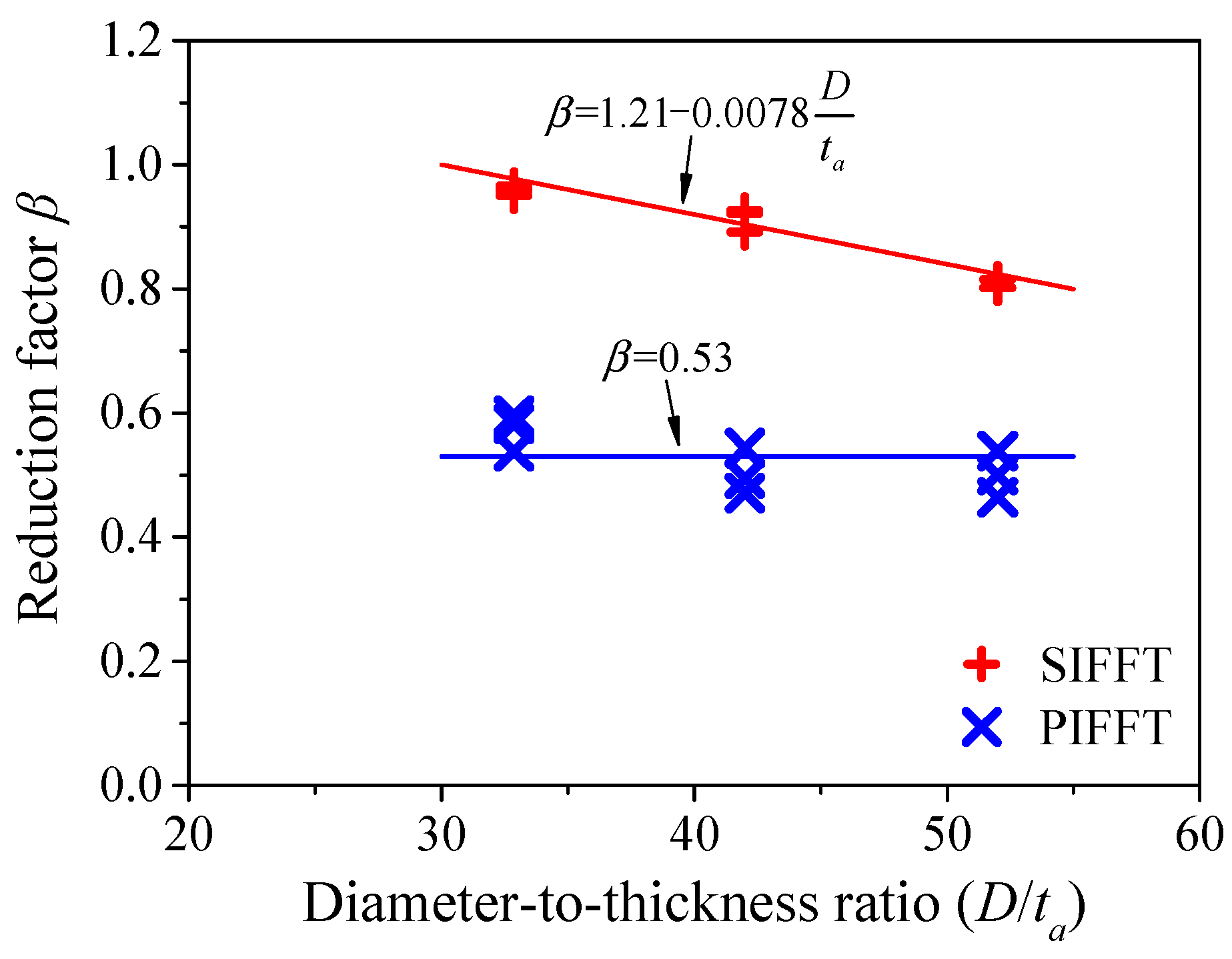
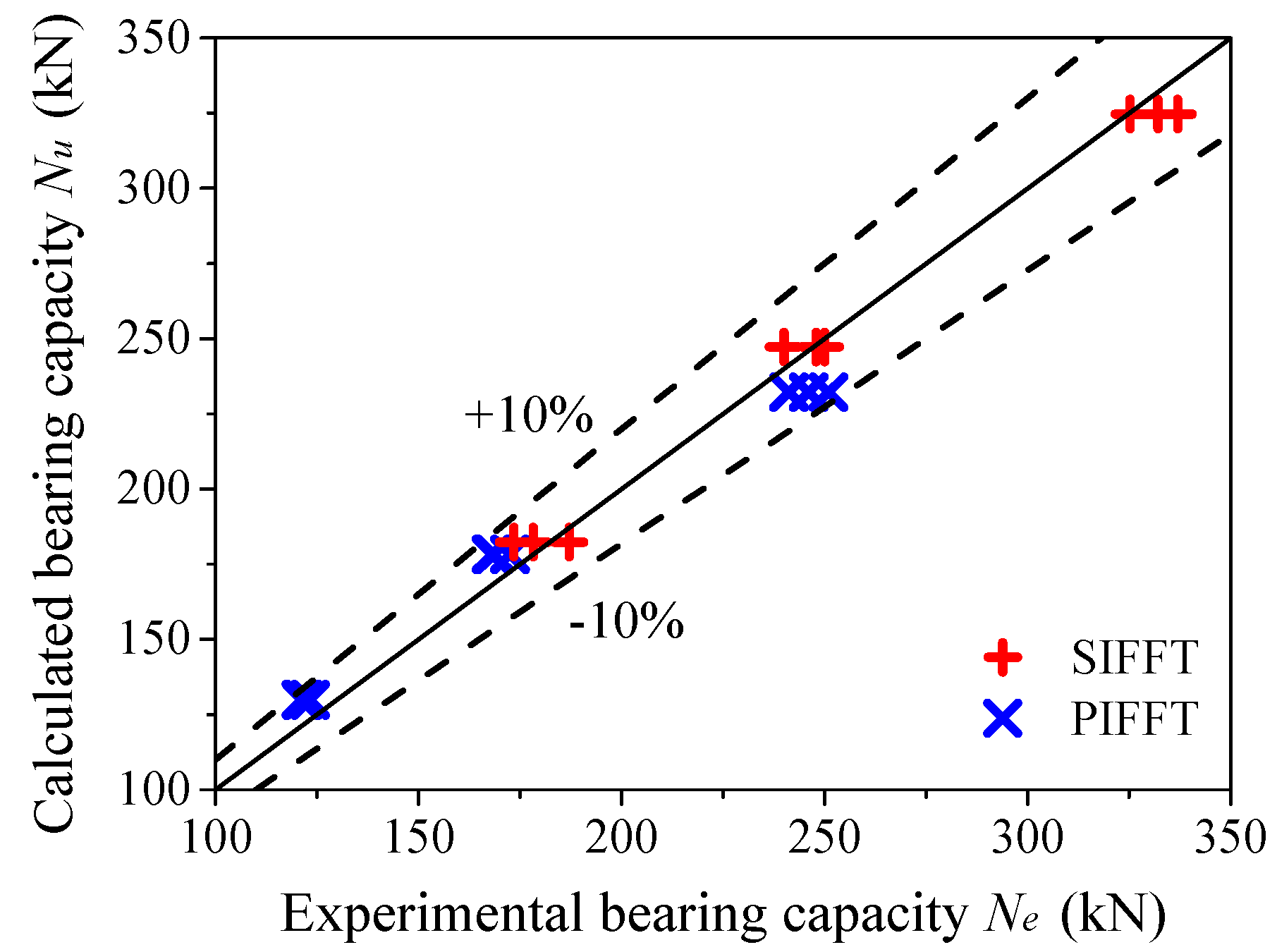
| Series | Specimen | Type of Ice Core | Flax FRP Tube | Test Results | |||||
|---|---|---|---|---|---|---|---|---|---|
| Ply | (mm) | (mm) | (kN) | Average
(kN) | Average
(kN) | ||||
| PI | PI0-I | PI | - | - | - | 49.79 | 48.98 | - | - |
| PI0-II | 48.18 | ||||||||
| PI0-III | 48.96 | ||||||||
| SI | SI0-I | SI | - | - | - | 74.82 | 75.61 | - | - |
| SI0-II | 75.62 | ||||||||
| SI0-III | 76.38 | ||||||||
| IF2 | IF2-I | PI | 2 | 0.27 | 3.00 | 123.27 | 122.00 | 82.66 | 0.927 |
| IF2-II | 121.13 | ||||||||
| IF2-III | 121.61 | ||||||||
| SF2 | SF2-I | SI | 2 | 0.27 | 3.00 | 187.09 | 179.61 | 82.66 | 1.364 |
| SF2-II | 178.24 | ||||||||
| SF2-III | 173.50 | ||||||||
| IF4 | IF4-I | PI | 4 | 0.54 | 3.75 | 168.01 | 169.72 | 103.01 | 1.117 |
| IF4-II | 172.51 | ||||||||
| IF4-III | 168.65 | ||||||||
| SF4 | SF4-I | SI | 4 | 0.54 | 3.75 | 250.01 | 245.98 | 103.01 | 1.618 |
| SF4-II | 247.95 | ||||||||
| SF4-III | 239.98 | ||||||||
| IF6 | IF6-I | PI | 6 | 0.81 | 4.86 | 250.94 | 245.39 | 135.56 | 1.330 |
| IF6-II | 241.21 | ||||||||
| IF6-III | 244.03 | ||||||||
| SF6 | SF6-I | SI | 6 | 0.81 | 4.86 | 332.02 | 331.36 | 135.56 | 1.796 |
| SF6-II | 325.18 | ||||||||
| SF6-III | 336.88 | ||||||||
| Series | Specimen | (MPa) | Average
(MPa) | (%) | Average
(%) | (%) | Average (%) | |||
|---|---|---|---|---|---|---|---|---|---|---|
| IF2 | IF2-I | 4.46 | 4.56 | 1.65 | 1.67 | 1.55 | 1.37 | 0.44 | 0.42 | 0.310 |
| IF2-II | 4.52 | 1.55 | 0.38 | |||||||
| IF2-III | 4.71 | 1.44 | 0.42 | |||||||
| SF2 | SF2-I | 6.78 | 6.37 | 1.49 | 2.65 | 2.63 | 1.09 | 0.91 | 0.84 | 0.628 |
| SF2-II | 6.34 | 2.60 | 0.84 | |||||||
| SF2-III | 6.01 | 2.65 | 0.78 | |||||||
| IF4 | IF4-I | 6.63 | 6.68 | 2.41 | 1.52 | 1.55 | 1.37 | 0.45 | 0.42 | 0.313 |
| IF4-II | 6.60 | 1.67 | 0.43 | |||||||
| IF4-III | 6.80 | 1.45 | 0.38 | |||||||
| SF4 | SF4-I | 8.78 | 8.60 | 2.01 | 3.02 | 2.99 | 1.24 | 0.81 | 0.85 | 0.633 |
| SF4-II | 8.64 | 3.04 | 0.94 | |||||||
| SF4-III | 8.39 | 2.91 | 0.79 | |||||||
| IF6 | IF6-I | 9.74 | 9.50 | 3.43 | 1.82 | 1.79 | 1.58 | 0.43 | 0.42 | 0.316 |
| IF6-II | 9.53 | 1.67 | 0.39 | |||||||
| IF6-III | 9.24 | 1.87 | 0.46 | |||||||
| SF6 | SF6-I | 11.43 | 11.40 | 2.66 | 3.35 | 3.35 | 1.39 | 0.90 | 0.90 | 0.668 |
| SF6-II | 10.99 | 3.41 | 0.82 | |||||||
| SF6-III | 11.78 | 3.29 | 0.96 |
© 2020 by the authors. Licensee MDPI, Basel, Switzerland. This article is an open access article distributed under the terms and conditions of the Creative Commons Attribution (CC BY) license (http://creativecommons.org/licenses/by/4.0/).
Share and Cite
Wang, Y.; Chen, G.; Wan, B.; Han, B. Compressive Behavior of Circular Sawdust-Reinforced Ice-Filled Flax FRP Tubular Short Columns. Materials 2020, 13, 957. https://doi.org/10.3390/ma13040957
Wang Y, Chen G, Wan B, Han B. Compressive Behavior of Circular Sawdust-Reinforced Ice-Filled Flax FRP Tubular Short Columns. Materials. 2020; 13(4):957. https://doi.org/10.3390/ma13040957
Chicago/Turabian StyleWang, Yanlei, Guipeng Chen, Baolin Wan, and Baoguo Han. 2020. "Compressive Behavior of Circular Sawdust-Reinforced Ice-Filled Flax FRP Tubular Short Columns" Materials 13, no. 4: 957. https://doi.org/10.3390/ma13040957
APA StyleWang, Y., Chen, G., Wan, B., & Han, B. (2020). Compressive Behavior of Circular Sawdust-Reinforced Ice-Filled Flax FRP Tubular Short Columns. Materials, 13(4), 957. https://doi.org/10.3390/ma13040957







